As genres of speculative fiction—fiction which aims to imaginatively influence the manifestation of our collective future—solarpunk and lunarpunk hold a promise that their ancestral foil (cyberpunk) does not. Whereas cyberpunk exercises a predominately negative, or critical, purpose by presenting a dystopian future we ought to avoid realizing, solar and lunarpunk both aim to envision positive alternatives inspired by a renewed cosmic spirituality. This may seem like an idiosyncratic characterization, but in what follows I will try to make clear why the recontextualization of humanity in a meaningful cosmos is what essentially distinguishes solar and lunar from cyberpunk. And, in accord with the pluralistic ethos Navarre opened this series with, I want to acknowledge from the outset that my characterizations may not resonate with everyone—and that’s okay. While it’s true that—in relation to the Earth—the Sun and Moon communicate distinct, archetypal characteristics, it’s also true that archetypes are polysemous: they manifest themselves in a range of meanings. And yet, if we are to discern what actually is archetypally lunar or solar, we must refer to realities that are not reducible to human social construction alone. Cyberpunk also partakes of the archetypal and might arguably be seen as a contemporary form of mythology conveying the dangers of hubris (think of Prometheus or Icarus). The major difference between these ancient myths and cyberpunk, however, is that between then and now has stretched a period of radical industrialization and its corresponding ecological devastation. Human hubris is writ large in the last century’s capitalist delusion of endless extraction and technological innovation cued to selfish ends. Solar and lunarpunk speculatively intervene to renew humanity’s sense of proportion (etymologically, the word “cosmos” arises from the Pythagorean-inflected κόσμος, which once denoted the universe as a harmonic order). Such speculative interventions are crucial given how pervasive the cyberpunk imaginary is today. The oft quoted saying (attributed to both Fredric Jameson and Slavoj Žižek)—“it is easier to imagine an end to the world than an end to capitalism”—exemplifies this pervasiveness, for cyberpunk stories are typically characterized by a form of capitalism pushed to its most inhuman extreme. We need only call to mind Blade Runner, Ghost in the Shell, or Akira and we can see this possible future in vivid detail:

The Earth has become a wasteland; cities provide the remainder of humanity refuge from the larger swaths of the planet that are now uninhabitable zones of nuclear fallout. Megacorporations have taken over the function of the state and exercise control over the cultural sphere, ensuring citizens are kept pacified by rituals of escapism (digital, chemical, etc.). The unfeeling, yet self-indulgent elites live high above the clustered and polluted chaos of the urban population, ruling over them through an authoritarian surveillance apparatus that records everyone’s activity. Nietzsche’s Übermensch is translated into a crude form of technological “enhancement” that only wealthy individuals can afford (unless you happen to be a test-subject); radically hybridized human-cyborg forms emerge and prompt one of the major questions of science fiction: What is the human being?

The punk in cyberpunk often manifests through unlikely protagonists who represent the last bastions of higher values by raging against the machine—against a “society” that cybernetically reproduces inhumanity like a cancer. Whether they be actual humans or synthetic imitations who choose to honor such values, these misfits work against the “high tech, low life” character of their surroundings and shine as beacons of hope for a more humane world. A consistent archetype is the anarchist hacker who deploys their skills to throw a wrench in the system or divulge emancipatory information to the public. Sadly, their struggles usually amount to little given how pervasively the cancer has metastasized. Civilization—in these stories—seems beyond saving. Rather than presenting salutary visions of collective human flourishing, the cyberpunk genre has generally served to warn us of what we could become. These warnings are still relevant given that our world has grown to resemble the cyberpunk imaginary ever-more as the years go by. The ongoing incarceration and persecution of whistleblowers like Julian Assange exemplifies the extent to which cyber rebels pose a threat to the corporation-state juggernaut. This is despicably hypocritical given that social media and search engine companies openly track all user activity that transpires through their platforms. Our daily digital habits feed machines designed to enslave our attention and, increasingly, to shape our desires in ways that perpetuate the ravenous hunger of the monster that is neoliberal capitalism. How do we escape this capture?
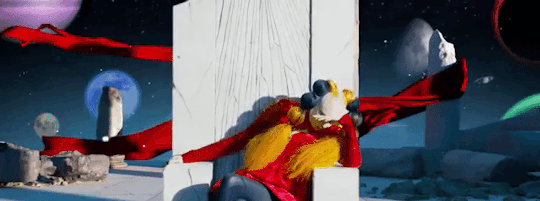
Enter solarpunk, the great potential of which is the return of the central, though unresolvable, question raised above—“What is the human being?”—to its cosmic context. Unlike cyberpunk, which, as a genre, broods over the dangers that arise from technologies borne of human alienation, solarpunk takes its inspiration from the more-than-human world—specifically, the giver of life on Earth: the Sun. Both genres reflect the Anthropocene—the name for our current geological age (cene) during which the human species (anthropos) has become a planetary force. But because the cyberpunk imagination is (typically) constrained to a mechanical vision of the cosmos, it perpetuates the worst kind of anthropocentrism—the kind which mistakes our theoretical models for reality. This mechanistic model—ranging from quantum physics, to biology, all the way to macroscopic cosmology—is defined exclusively by the inorganic laws of nature and can thus only amount to a vision of death. The mysteries of life and human consciousness—in this imaginary—are reduced to sophisticated computational processes that will soon be both explained and rendered obsolete by the rapidly evolving machinations of artificial intelligence. According to adherents of this mythos, technoscience will one day realize its ultimate goal: material immortality.
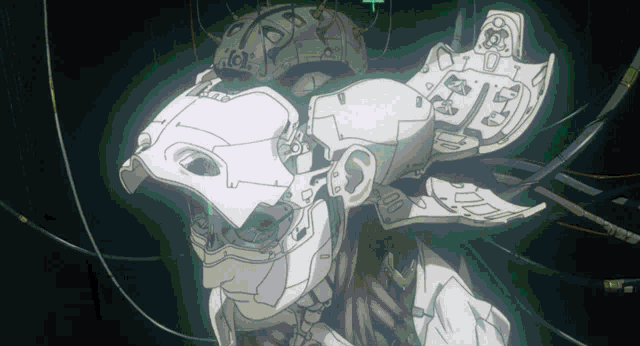
Solarpunk arises dialectically as a healthy reaction to the death-drive made conscious by cyberpunk and responds by reinstating the primacy of Life in the rhythmic organism that is our cosmos. Mechanism is subsidiary to organism, the organic; life is not *in* molecules; rather, molecules arise from the symphonic action of the entire cosmos and this music is life. The wish of solarpunk is to let the light of this cosmic Life inspire all of science and invention. What are science and technology for if not the flourishing of humanity and the wider Earth-community on which we depend? As Matt Bluemink writes, “at its core, solarpunk is the ecological antidote to cyberpunk… [an impetus] to imagine a world where human beings live in harmony with nature, but in a way that embraces developments in modern eco-friendly technology.” To live in harmony with nature is to rediscover the spiritual symphony of our living cosmos. Apart from the more obvious association with solar-power and renewable energy, the solar in solarpunk also refers to the salvific fire of optimism. Solarpunks are punk to the extent that their willful optimism goes against the grain of today’s complacent irony, cynicism, and destructive nihilism. And, sharp contrast to the extrinsic individuality that characterizes cyberpunk societies (and today’s neoliberalism), the solarpunk ethos implies a perception of humanity as a whole—a whole organism to which we as individuals belong. As Adam Flynn writes in Solarpunk: Notes toward a manifesto, “Solarpunk is about finding ways to make life more wonderful for us right now, and more importantly for the generations that follow us – i.e., extending human life at the species level, rather than individually.” The films of Hayao Miyazaki are among the major influences on the solarpunk aesthetic, and this is unsurprising given that Miyazaki’s films are saturated with an environmental ethic that flows from the Japanese Shinto tradition. Indeed, it seems that solarpunk is generally inspired by indigenous wisdom traditions to reintegrate humanity in the great web of life.

Though this characterization is by no means exhaustive, I have tried to distill what seems most essential to the spirit (or spirituality) of solarpunk: the light of optimism, the primacy of Life, and the perception of an underlying wholeness (i.e. the human species, the web of life, etc.). And—importantly—these features are not arbitrary, but issue directly from our actual experience of the genre’s namesake: Sol, the Sun. Those who have spent a substantial amount of time enduring frigid nights will know how natural it is to connect the light of optimism with the promise of sunrise. Anyone who pays attention to the flora and fauna of their local environs will know what praises Life sings to the break of dawn. And many will have heard the saying, “For he makes his sun to shine on bad and good people alike.” We do not make these things up; we either attend to such features or blind ourselves to them. The spirituality of solarpunk consists in choosing to recognize that an essential part of our humanity is connected with the Sun, that we are partially constituted by it, and that, just as it inspired our ancestors for thousands of years, it can likewise guide our own aspirations for the Anthropocene. This light-filled renewal of cosmic spirituality is one possible future; a darker future, presented by cyberpunk, consists in the further intensification of alienated anthropocentrism and its ironic apotheosis in the subhuman automaton. We have reached a fork in the road.
Astrologically speaking, we are on the cusp of Pluto’s ingress into the sign of Aquarius (a 20 year transit in total) which many astrologers predict will usher in a form of surveillance more oppressive than we have yet to experience. Many astrologers also anticipate the boundary between machines and (some) humans to increasingly blur. The pervasiveness of the cyberpunk imaginary certainly facilitates our passive entry into this Brave New World, but have the hopeful tales and practical initiatives of solarpunk done enough to prepare us to face the panoptic beast of mass surveillance? Rachel-Rose O’Leary doesn’t think so, and in her widely circulated essay “Lunarpunk and the Dark Side of the Cycle,” she furthers the dialectic of cyber and solar by positioning lunarpunk as a kind of higher synthesis of the two. According to O’Leary’s genealogy, lunarpunk flows from the lineage of cypherpunk—a movement of coder-activists who anticipated the coming dangers of mass surveillance already in the early 1990s. Cypherpunks—including Julian Assange—advocated for and innovated encryption techniques to protect user privacy. Unlike the anonymity enjoyed in the analog world of cash exchange, digital transactions are vulnerable to prying eyes. As Eric Hughs writes in “A Cypherpunks Manifesto,” “when my identity is revealed by the underlying mechanism of the transaction, I have no privacy. I cannot here selectively reveal myself; I must always reveal myself.” It is this freedom to selectively reveal oneself that cypherpunks aim to protect. Why? As Hughs writes, “we cannot expect governments, corporations, or other large, faceless organizations to grant us privacy out of their beneficence. It is to their advantage to speak of us, and we should expect that they will speak.” The parasitic collaboration between advertisers and social media companies to farm our attention is an obvious example of what happens when we allow such entities to “speak of us.” China’s inhumane, authoritarian public health measures are another example of what can happen when citizens lack the negative freedom (protection) of privacy. As early resistors to mass surveillance, cypherpunks resemble the rebellious (because humane) protagonists of cyberpunk stories. And indeed, as O’Leary characterizes the subgenre, lunarpunk continues this resistance, reminding solarpunks that utopia will only ever be elsewhere, while dystopia is nigh.
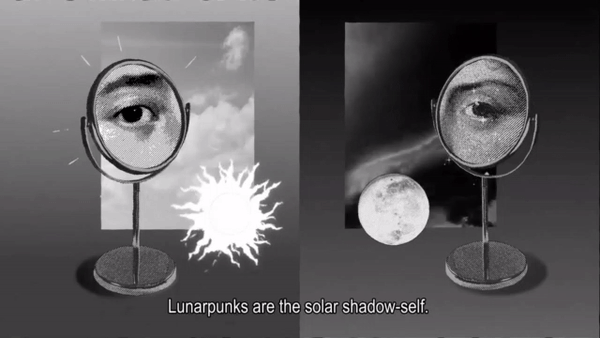
But, significantly, O’Leary isn’t writing speculative fiction, rather, she seems to be going a step further by attempting a more direct intervention into history itself, engaging in what might be called mythospeculation. But she doesn’t claim to be any kind of messiah, rather, she points to the advent of crypto as containing its own speculative, sci-fi potential. As she writes, “crypto is an extreme kind of sci-fi because as well as offering a vision of the future it also provides the tools to make that future possible.” She goes on to describe how the future of crypto is predominately envisioned through the idealism of solarpunk. Now there are many in the solarpunk movement who reject the whole world of crypto as merely a transposition of neoliberal capitalism into the digital sphere. A thread in the solarpunk subreddit titled “Crypto is not (solar)punk” provides a snapshot of the various perspectives involved in the debate. As one user writes,
“Regardless of the environmental impacts, which are sus at best, creating an unregulated currency that is already controlled by the rich and powerful and literally siphoning production and wealth out of the labor force of the country with get-rich-quick schemes, pump and dump, and pyramid schemes is not my idea of solarpunk. Currency as we know it wouldn’t even be needed in a truly post-scarcity solarpunk world. Cryptocurrency is just capitalism turned up to 11.”
With the recent downfall of FTX we know that this is indeed an accurate characterization of some developments in the world of crypto, but others argue that this just proves the true potentials of blockchain technology have yet to be tapped. Another user in the subreddit debate conveys this with respect to the capabilities of NFTs:
“an NFT is really just any data stored on a blockchain that isn’t interchangeable with the other items on it (in the way that one bitcoin can be interchanged with any other bitcoin, because they’re all the same as each other). That means that NFTs could conceivably be used not just for securely keeping track of ownership, but generally for issuing records that can’t be forged or modified, or (along with smart contracts) exchanging data between two parties when the terms of an agreement are fulfilled. We can do those things without trusting a third party – or really, trusting anything except math – and without centralizing authority in the hands of a bureaucracy which might become inefficient, abusive of its power, or corrupt. A large part of solarpunk is the smart and responsible application of technology to improve our lives, and if blockchains were applied properly, they have the potential to legitimize and strengthen the sort of bottom-up social relations that, to me, are vital to the successful implementation of solarpunk ideals.” It is presumably this capacity to cut out third parties (i.e. banks, governments, etc.) and the centralizing power such entities currently enjoy that makes crypto, as O’Leary suggests, an “extreme form of sci-fi” by providing the “tools to make that future possible.”
Blockchain technology, as this user points out, enables peer-to-peer transactions that could provide bottom-up, grassroots movements an economic alternative to the state-mediated systems currently in place. This potential of decentralization is presumably what O’Leary means when she describes crypto as an extreme form of sci-fi, one that provides a vision and the tools to realize it. Unfortunately this potential is hampered by another widely celebrated feature of the blockchain—transparency, the expectation being that public access to transactions will mitigate corruption, or at least make it easy to spot when it does take place. But if we recall the central concern of cypherpunks—privacy—then we might rightly hesitate to celebrate a technology that exposes our transactions to prying eyes. Indeed, this is O’Leary’s main concern, for while many in the Global North might look upon the insistence for privacy with suspicion, those who have faced state-sanctioned oppression know better. That O’Leary knows better becomes evident in another article in which she compares the lunarpunk insistence on encryption with the guerilla style warfare of the Irish during their recent revolutionary period:
“Fighters lacked weapons, but the people and rugged landscape protected them. The new warfare favored hit-and-run tactics and disrupting enemy intelligence. It was the dawn of modern guerrilla tactics – and it won Ireland its independence. These guerilla tactics are no longer feasible today. Modern surveillance technologies and automated weaponry have turned the world that we inhabit into a desert with no protective cover. Resistance fighters are easy targets.”
Transparency, for O’Leary, is like the first iteration of the Irish revolution—when Irish fighters tried to overcome colonial rule by occupying the most public outposts of their territory. But being so conspicuous backfired when the British army arrived and closed-in, catalyzing the recourse to guerilla tactics. Today’s mass surveillance is a similar development. Those solarpunks who, having recognized the emancipatory potential of crypto, opt to join forces with popular blockchains like Ethereum and Bitcoin, put themselves at risk when—in the near future—state regulation sweeps in and transparency backfires. O’Leary and others in the DarkFi movement refer to the latter development—state-based crypto regulation—as “the coming storm,” and position lunarpunk as a revolutionary countermeasure. As she writes, “lunarpunk is a guerrilla movement committed to establishing a digital forest in cypherspace using tools like encryption that its fighters can recede into.”
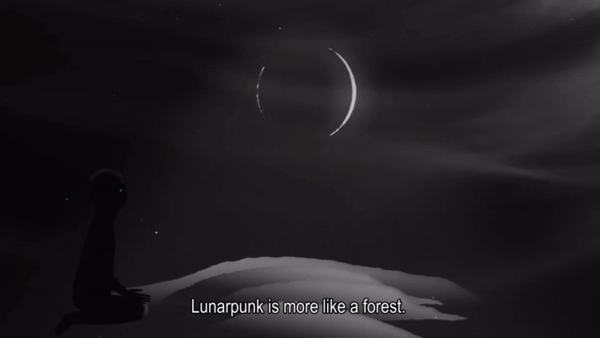
In contrast, “by building transparent systems, the solarpunk says: I have faith that the law won’t turn against me. Its insistence on optimism prevents it from preparing for the worst case scenario.” She goes on to compare this situation with the harsh desert landscape where there is no cover, no escape from the relentless exposure of sunlight. In stride with the aforementioned astrologers who anticipate Pluto’s ingress into Aquarius to herald new depths of surveillance, lunarpunks are fostering the growth of forest-cover in cypherspace in hopes of preserving the mere possibility of freedom. O’Leary and others in the DarkFi movement refer to this anonymizing process as “going dark” and in so doing articulate a key feature of lunarpunk. Whereas some solarpunks enthused with crypto might hold out hope for transforming the current system through public projects transparently mediated through Ethereum, lunarpunk—according to O’Leary—is about seceding from the system altogether. As she writes in her conclusion to “Lunarpunk and the Dark Side of the Cycle,”
“Lunarpunk’s believe freedom can only be found outside the logic of domination. This means lunar society must completely decouple itself from the current paradigm. As such the lunarpunk future is born from a conflict that solarpunks seek to avoid.
This solarpunk repression is its weakest point. Solarpunk cannot build the vision it projects if it has already integrated the oppression that it hopes to break away from. By favoring transparency in its systems, solarpunk is tragically engineering its fate. Surveillance – the mechanism of authoritarianism – is bound to the solarpunk destiny.
For solarpunk to succeed it must integrate the lunarpunk unconscious. The only hope for solarpunk is to go dark.”
Just as many in the solarpunk movement reject crypto altogether, many might also take issue with the claim that solarpunk has “integrated the oppression it hopes to break away from.” This may not be true of the movement broadly speaking, but it is an unfortunate fact that the greenwashing powers of capitalism have already made inroads into solarpunk aesthetically. The short film “Dear Alice,” a Miyazaki-inspired animation, is a case in point because it doubles as an advertisement for the Greek yogurt company Chobani. The product placement is truly cringe in an otherwise diverse, utopian vision of a solarpunk future. The presence of a decommodified version of the animation on YouTube and a thread discussing the advertisement on the solarpunk subreddit are enough to show that many in the movement do not wish to capitulate to the powers that be.
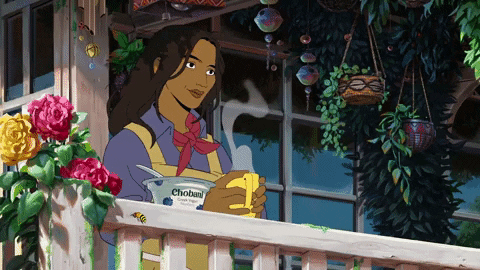
As O’Leary understands it, the darkness of lunarpunk refers not only to the cover of anonymity, but also the willingness to look into the dark—to accept uncomfortable truths. For lunarpunks this means embracing the fact that we are living in the midst of a dying empire—a phase of decline which typically features an intensified effort of the state to exert control over citizens—hence the unwillingness to reform. And like fungi in the midst of this decay, the lunarpunks of DarkFi are generating an anonymity-focused layer 1 (foundational) blockchain in hopes of fostering a decentralized economy that could unite a patchwork federation of anarchist communities around the globe. Herein lies another important feature of lunarpunk: the recognition that—out of death—new life can emerge. And whereas solarpunk especially emphasizes a compassionate perception of humanity as a whole (including the future of our species), lunarpunks insist on the integral role each individual plays in the moral drama of history. Up until this point a question may have been hovering in the mind of the reader: “But isn’t anonymity a potential hazard? Won’t it incentivize and facilitate criminal behavior?” Justin Murphy posed this question to O’Leary during a dialogue the two had on the zero-knowledge crypto-anarchy of DarkFi; her response conveys the spirituality that undergirds true anarchy when understood as an ethical form that arises spontaneously from the human heart when we have had the chance to grow into virtue rather than be coerced to imitate it:
“I don’t think anonymity is necessarily a catalyst for bad things, and I also have optimism and faith in people, and I don’t think we need to persecute everyone with this invasive surveillance in order to protect us. No, I believe that people can live ethically and that their ethics should come from themselves and not be imposed on them… let the people do their things, fulfill their destinies—let that arise from them organically, as it should, in the spirit of affirmation.”
By insisting on the negative freedom that cryptography provides (freedom from prying eyes and coercion), it might seem like lunarpunks prize technological fixes over the cultivation of inner freedom and virtue. But the convictions O’Leary expresses above convey the exact opposite. The negative freedom of privacy becomes necessary in our technologically mediated world so as to carve out enclaves where the positive freedom of affirmation can flourish organically. One might discern echoes of Nietzche’s yea-saying here. Cryptography can support the latter, but true virtue can only arise out of individual self-transformation. No technology—no matter how sophisticated—can achieve this for us. Such transformation is the spiritual basis of ethical anarchy. If solarpunk steers science and technology away from the alienated and hubristic ends of cyberpunk, lunarpunk rounds off by reminding us that the key to a future of mutual flourishing ultimately lies within.
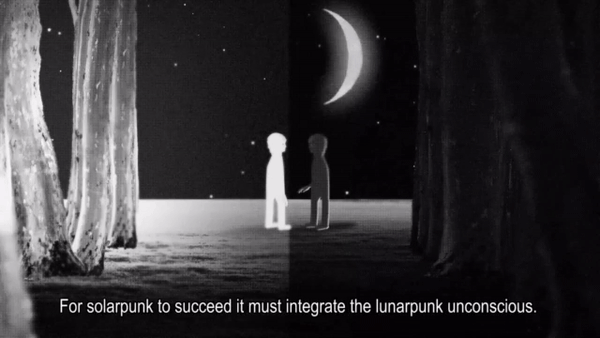
Heeding O’Leary’s appeal, Dr. Paul J. Dylan-Ennis imagines a harmonization of solar and lunarpunk achieved when the former integrates the latter by going dark. “Absolutely, in terms of strategy,” he writes,
“Yet, we should also demand the light, the transparent fullness of solarpunk optimism. This is how I imagine a perfect synthesis of solar- and lunarpunk. A transparent society of utopic quality (demand nothing less) protected by a vigilant darkness. Without the light what is there to protect anyway? We should never give up the sun to the state.”
Amen—we should never give up the Sun to the state, for the transparent light of surveillance is only a counterfeit of the true, life-giving light of our star. Dylan-Ennis’ vision of synthesis and O’Leary’s Jungian call for solarpunk to “integrate the lunarpunk unconscious,” are—in my perspective—contemporary intimations of the ancient Pythagorean understanding of the cosmos as a harmonic order. But this harmonic order is not something that is merely given, rather, it is something human beings must participate in if we wish to keep the music of the universal process going. The bare attempt to discern the distinct archetypal character of Sun and Moon at work in these subgenres and the relation that inheres between them is an exercise in this cosmic participation, this renewal of cosmic spirituality. If, in the constraints of this post, we take the light of optimism, the primacy of Life, and the perception of an underlying wholeness to convey the essence of solarpunk, lunarpunk bodies forth the inverse: a familiarity with darkness that wisely guides the light of optimism, a sober recognition that the mystery of Life is ineluctably bound up with the mystery of Death (including the death of empires), and—alongside the light-filled perception of wholeness—an equal respect for difference, for the multeity at work in this harmonic unity we call our cosmos. Whereas the Sun, shining on all below irrespective of differences, occupies the daytime sky alone, the Moon shares the vault of heaven with other planets and a countless host of starry worlds. Contemplating this great celestial diversity, we are filled with awe, perhaps terror—or maybe even a bit of both. Just as the Sun can shed light on what it means to be human and guide our aspirations for the future, so too can the Moon. Unless (or until!) we discover humanoid beings elsewhere in the universe, we ought to measure our essence in close connection with the planet which hosts us: Earth. We are not just on the Earth, but are brought forth through the dynamism of its being. But the Earth would not be what it is if it were not simultaneously dancing with the Sun and the Moon. The three celestial bodies constitute a whole in the form of a tri-unity, with Earth harmonizing the polar extremes of Sun and Moon. Unlike the irresolvable negation of contradiction—the stasis of binary opposition—the tri-unity is a dynamic, ever-evolving harmony that recapitulates itself at all scales throughout the cosmos. In a similar vein, BrightFlame speaks of the “nonbinary nature” of solar and lunarpunk, describing their connection “as varied and changeable, not fixed like a molecular bond,” that they “don’t just touch one another, they overlap.” Her characterization is reminiscent of how many have described the Chinese yin-yang which features an interpenetration of light and darkness, one that is more suggestive of a dynamic tri-unity than a static, binary opposition.

The same intuition of threefoldness manifests itself in the Celtic triquetra. Indeed, a trinity in some shape or form shows up in the symbol systems of many ancient cultures across the globe, a fact which may be taken to suggest that the harmony of three was an obvious feature of the natural world for our ancestors. But between now and then our thinking—especially when it comes to number—has become woefully abstract. The emergence of lunarpunk in wake of solarpunk bespeaks the potential each imaginary has for overcoming this abstractness through a reattunement the meaningfulness of the more-than-human world. That this is already happening is evident in the sequence of their articulation: given that we are beings of the Earth—cradled between the weaving of Sun and Moon—it was inevitable that a genre inspired by the light of day would be followed by the darkness of night. The two constitute a polarity, a rhythm—a dynamic relationship undergirded unity (i.e. harmony). Aesthetic sensitivity to the natural world expresses itself as a creative continuation of this polar rhythm. We see this in the first characterizations of both genres, but particularly in the effort to articulate the essence of lunarpunk always in relation to solarpunk. As Justine Norton-Kertson writes, “Lunarpunk is to Solarpunk as flowers are to fungi”—a very apt transposition of this polarity, for most flowers do open to greet the daylight, whereas mushrooms tend to thrive in the damp breath of shadows.
If cyberpunk serves to warn us of the destructive potential that human hubris writ large spells for the future, solar and lunarpunk—taken together—enjoin human beings to become capable of comprehending the speaking world once more. This renewal of cosmic spirituality is what we need to offset the damage that has been and will continue to be wrought by technologies concocted by alienated anthropocentrism. Only a spirituality that flows from a recognition of our cosmic context will know how to wield the power of technology responsibly. Though we cannot separate solar and lunarpunk, we can and must distinguish them to better understand the task ahead. Sol ignites the salvific light of optimism, reattunes science and technology to the primacy of Life, and perceives the wholeness of humanity and the Earth community; Luna reminds us that we’re already in the midst of a dystopian cyberpunk story, that we can skillfully negotiate the decay of empire by receding into the dark forest of a parallel cypherspace-economy, and that this technology can help to safeguard the freedoms necessary, though not sufficient for, human actualization. Most of all, Luna reminds us that the latter—the actualization of human potential—can only be achieved at the individual level as we each work inwardly to transform ourselves into ethical beings who are capable of partaking in the spiritual anarchy of the future by striving to live up to it in the present.
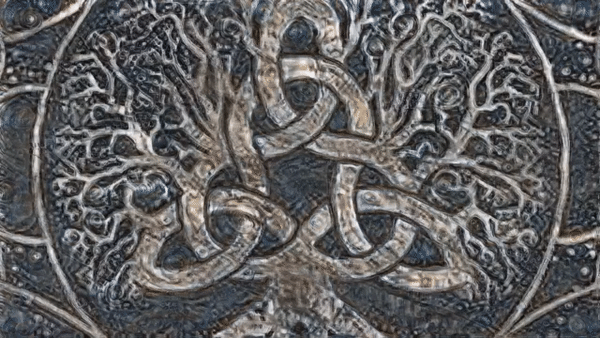
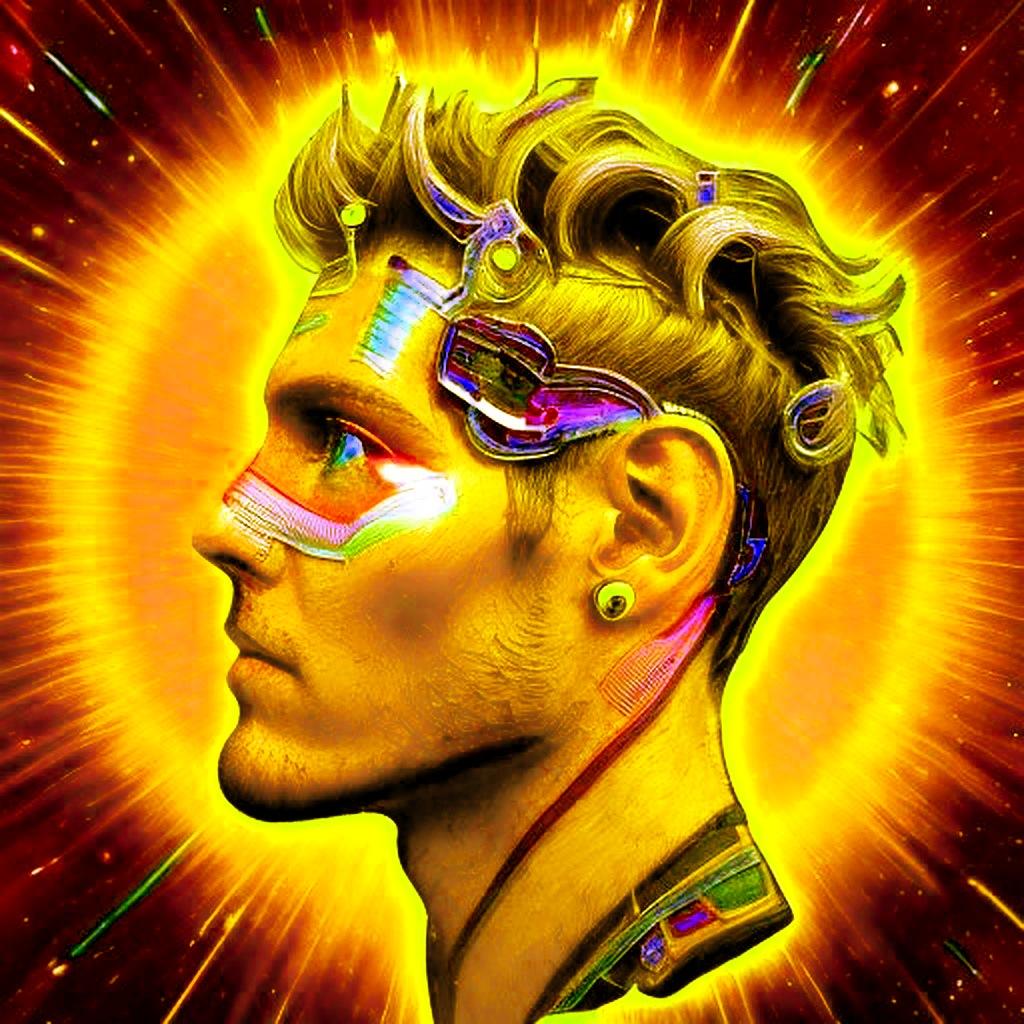
Ashton K. Arnoldy is a Ph.D. candidate in the Philosophy, Cosmology, and Consciousness program at the California Institute of Integral Studies; his dissertation is focused on the evolution of consciousness as presented by Owen Barfield. Ashton doubles as Aʅʂσ Kɳσɯɳ Aʂ, a multimedia avatar dedicated to fostering anthropogenesis and cosmological orientation. For more, check out the multimedia lunarpunk series Lunar Return, the blog/podcast MicroKosm, and the weekly Calendar of the Soul livestream.
Pingback: I Didn't Listen to Myself ⋆ BrightFlame